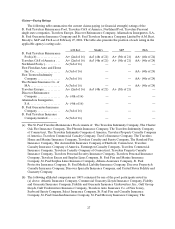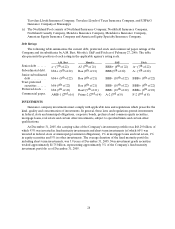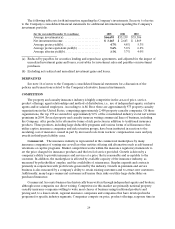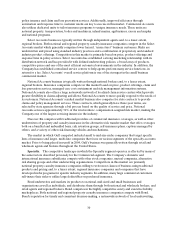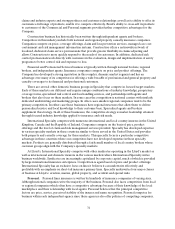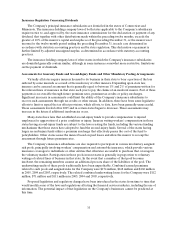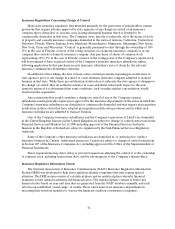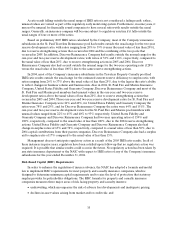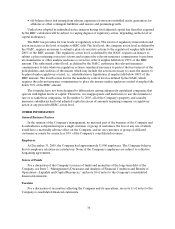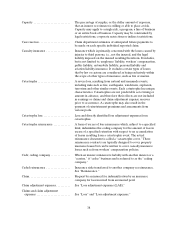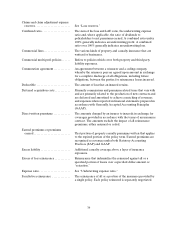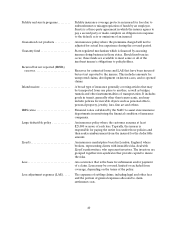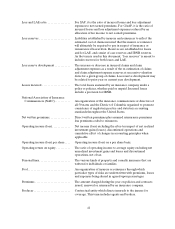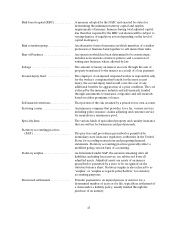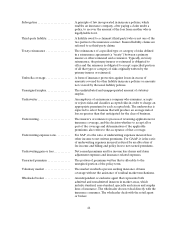Travelers 2005 Annual Report Download - page 46
Download and view the complete annual report
Please find page 46 of the 2005 Travelers annual report below. You can navigate through the pages in the report by either clicking on the pages listed below, or by using the keyword search tool below to find specific information within the annual report.34
Insurance Regulations Concerning Change of Control
Many state insurance regulatory laws intended primarily for the protection of policyholders contain
provisions that require advance approval by state agencies of any change in control of an insurance
company that is domiciled, or, in some cases, having substantial business that it is deemed to be
commercially domiciled, in that state. The Company owns, directly or indirectly, all of the shares of stock
of property and casualty insurance companies domiciled in the states of Arizona, California, Connecticut,
Delaware, Florida, Illinois, Indiana, Iowa, Maryland, Massachusetts, Minnesota, Mississippi, New Jersey,
New York, Texas and Wisconsin. “Control” is generally presumed to exist through the ownership of 10%
(5% in the case of Florida) or more of the voting securities of a domestic insurance company or of any
company that controls a domestic insurance company. Any purchaser of shares ofcommon stock
representing 10% (5% in the case of Florida) or more of the voting power of the Company’s capital stock
will be presumed to have acquired control of the Company’s domestic insurance subsidiaries unless,
following application by that purchaser in each insurance subsidiary’s state of domicile, the relevant
insurance commissioner determines otherwise.
In addition to these filings, the laws of many states contain provisions requiring pre-notification to
state agencies prior to any change in control of a non-domestic insurance company admitted to transact
business in that state. While these pre-notification statutes do not authorize the state agency to disapprove
the change of control, they do authorize issuance of cease and desist orders with respect to the non-
domestic insurer if it is determined that some conditions, such as undue market concentration, would
result from the acquisition.
Any transactions that would constitute a change in control of any of the Company’s insurer
subsidiaries would generally require prior approval by the insurance departments of the states in which the
Company’s insurance subsidiaries are domiciled or commercially domiciled and may require preacquisition
notification in those states that have adopted preacquisition notification provisions and in whichsuch
insurance subsidiaries are admitted to transact business.
One of the Company’s insurance subsidiaries and the Company’s operations at Lloyd’s are domiciled
in the United Kingdom. Insurers in the United Kingdom are subject to change of control restrictions in the
Financial Services and Markets Act of 2000 including approval of the Financial Services Authority.
Insurers in the Republic of Ireland are subject to regulation by the Irish Financial Services Regulatory
Authority.
Some of the Company’s other insurance subsidiaries are domiciled in, or authorized to conduct
insurance business in, Canada. Authorized insurers in Canada are subject to change of control restrictions
in Section 407 of the Insurance Companies Act, including approval of the Office of the Superintendent of
Financial Institutions.
These requirements may deter, delay or prevent transactions affecting the controlof or the ownership
of common stock, including transactions that could be advantageous to the Company’s shareholders.
Insurance Regulatory Information System
The National Association of Insurance Commissioners (NAIC) Insurance Regulatory Information
System (IRIS) was developed to help state regulators identify companies that may require special
attention. The IRIS system consists of a statistical phase and an analytical phase whereby financial
examiners review annual statements and financial ratios. The statistical phase consists of twelve key
financial ratios based on year-end data that are generated from the NAIC database annually, and each
ratio has an established “usual range” of results. These ratios assist state insurance departments in
executing their statutory mandate to oversee the financial condition of insurance companies.





